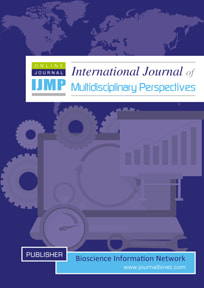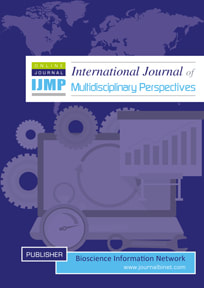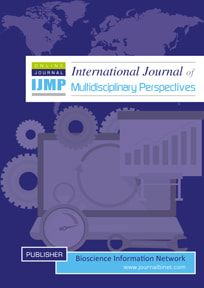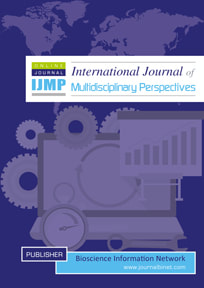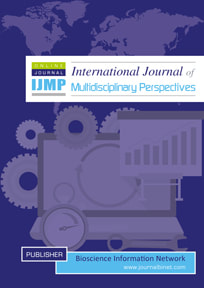International Journal of Multidisciplinary Perspectives
You are here: Home>IJMP Journal>Archive>Volume 04
Volume 04 - Issue 01 | Year of Publication: 2023
Article Type: Research Article | No. 13 | Country: Bangladesh | pp. 82-86 | Open Access
Title: Impact of fertilizer sources, both organic and inorganic, on Aloe vera
Authors: Simi, F. and Hossain, M. J.
DOI: http://dx.doi.org/10.18801/ijmp.040123.13
Title: Impact of fertilizer sources, both organic and inorganic, on Aloe vera
Authors: Simi, F. and Hossain, M. J.
DOI: http://dx.doi.org/10.18801/ijmp.040123.13
Impact of fertilizer sources, both organic and inorganic, on Aloe vera
Abstract
This study examined the effects of various amounts of organic and inorganic fertilizers on the leaf and plant features as well as the yield of aloe vera at the Bangladesh Institute of Research and Training on Applied Nutrition (BIRTAN), Barishal. There were 14 different treatments viz., T1=100% control, T2=50% cowdung + 50% chemical fertilizer, T3=100% vermicompost, T4=100% cowdung, T5=50% sawdust+ 50% chemical fertilizer, T6=100% cocodust, T7= 50% compost+ 50% chemical fertilizer, T8= 100% poultry litre, T9= 50% vermicompost + 50% chemical fertilizer, T10= 100% sawdust, T11= 50% poultry litre+ 50% chemical fertilizer, T12= 50% cocodust+ 50% chemical fertilizer, T13= 100% compost, T14= 100% chemical fertilizer. With the application of the T5 treatment (50 % sawdust+ 50 % chemical fertilizer), it was found that the plant generated the highest mature leaf length, leaf breadth, fresh leaf weight, leaf yield per plant and gel yield per plant. The number of suckers was also discovered to be highest with T13 treatment above 100% control, among other plant characteristics. Several fertilizer treatments considerably impacted the rate at which leaves grew, with the early phases of each treatment showing the most significant impact. It was discovered that T9 had less impact than T5 (50% sawdust+ 50% chemical fertilizer) on the Aloe vera plant's characteristics.
Key Words: Aloe vera, fertilizer, Organic, Inorganic and leaf growth
Abstract
This study examined the effects of various amounts of organic and inorganic fertilizers on the leaf and plant features as well as the yield of aloe vera at the Bangladesh Institute of Research and Training on Applied Nutrition (BIRTAN), Barishal. There were 14 different treatments viz., T1=100% control, T2=50% cowdung + 50% chemical fertilizer, T3=100% vermicompost, T4=100% cowdung, T5=50% sawdust+ 50% chemical fertilizer, T6=100% cocodust, T7= 50% compost+ 50% chemical fertilizer, T8= 100% poultry litre, T9= 50% vermicompost + 50% chemical fertilizer, T10= 100% sawdust, T11= 50% poultry litre+ 50% chemical fertilizer, T12= 50% cocodust+ 50% chemical fertilizer, T13= 100% compost, T14= 100% chemical fertilizer. With the application of the T5 treatment (50 % sawdust+ 50 % chemical fertilizer), it was found that the plant generated the highest mature leaf length, leaf breadth, fresh leaf weight, leaf yield per plant and gel yield per plant. The number of suckers was also discovered to be highest with T13 treatment above 100% control, among other plant characteristics. Several fertilizer treatments considerably impacted the rate at which leaves grew, with the early phases of each treatment showing the most significant impact. It was discovered that T9 had less impact than T5 (50% sawdust+ 50% chemical fertilizer) on the Aloe vera plant's characteristics.
Key Words: Aloe vera, fertilizer, Organic, Inorganic and leaf growth
MLA
Simi, and Hossain. “Impact of fertilizer sources, both organic and inorganic, on Aloe vera”. International Journal of Multidisciplinary Perspectives, 04(01) (2023): 82-86.
APA
Simi, F. and Hossain, M. J. (2023). Impact of fertilizer sources, both organic and inorganic, on Aloe vera. International Journal of Multidisciplinary Perspectives, 04(01), 82-86.
Chicago
Simi, F. and Hossain, M. J. “Impact of fertilizer sources, both organic and inorganic, on Aloe vera”. International Journal of Multidisciplinary Perspectives, 04(01) (2023): 82-86.
Harvard
Simi, F. and Hossain, M. J. 2023. Impact of fertilizer sources, both organic and inorganic, on Aloe vera. International Journal of Multidisciplinary Perspectives, 04(01), pp. 82-86.
Vancouver
Simi, F and Hossain, MJ. Impact of fertilizer sources, both organic and inorganic, on Aloe vera. International Journal of Multidisciplinary Perspectives, 2023 March 04(01), 82-86.
Simi, and Hossain. “Impact of fertilizer sources, both organic and inorganic, on Aloe vera”. International Journal of Multidisciplinary Perspectives, 04(01) (2023): 82-86.
APA
Simi, F. and Hossain, M. J. (2023). Impact of fertilizer sources, both organic and inorganic, on Aloe vera. International Journal of Multidisciplinary Perspectives, 04(01), 82-86.
Chicago
Simi, F. and Hossain, M. J. “Impact of fertilizer sources, both organic and inorganic, on Aloe vera”. International Journal of Multidisciplinary Perspectives, 04(01) (2023): 82-86.
Harvard
Simi, F. and Hossain, M. J. 2023. Impact of fertilizer sources, both organic and inorganic, on Aloe vera. International Journal of Multidisciplinary Perspectives, 04(01), pp. 82-86.
Vancouver
Simi, F and Hossain, MJ. Impact of fertilizer sources, both organic and inorganic, on Aloe vera. International Journal of Multidisciplinary Perspectives, 2023 March 04(01), 82-86.
Article Type: Research Article | No. 14 | Country: Germany | pp. 87-96 | Open Access
Title: Assessing urban spatial patterns within the implemented urban planned areas using GIS and remote sensing data
Authors: Enoguanbhor, E. C.
DOI: http://dx.doi.org/10.18801/ijmp.040123.14
Title: Assessing urban spatial patterns within the implemented urban planned areas using GIS and remote sensing data
Authors: Enoguanbhor, E. C.
DOI: http://dx.doi.org/10.18801/ijmp.040123.14
Assessing urban spatial patterns within the implemented urban planned areas using GIS and remote sensing data
Abstract
In the developing world, including Sub-Saharan Africa, reports have indicated that urban planning as a strategic instrument has not been able to guide urban spatial patterns and this poses challenges to improving urban environmental sustainability. The current study combined a city land use plan, Geographical Information Systems, and remotely sensed data to evaluate urban spatial patterns within areas where the city plan is reported to have been implemented to support strategic actions for urban environmental sustainability. Focusing on Abuja city, Nigeria, the study deployed a supervised classification on Landsat 8 remotely sensed data to analyze spatial patterns of urban land cover types, computed transition change detections and compared the urban impervious surface to the area of land designated for urban development by the city plan. Key findings indicated that the land areas designated for urban development have not been fully developed and the transition from urban green space is the highest transition from other land cover types to urban impervious surface. The baseline information provided in this study is crucial to inform decision-makers on improving and maintaining the implementation of strategic actions for urban environmental sustainability in Sub-Saharan African cities and other parts of the developing world.
Key Words: Strategic actions, Urban planning, Urban impervious surface, Urban environmental sustainability, Sub-Saharan Africa and Developing world.
Abstract
In the developing world, including Sub-Saharan Africa, reports have indicated that urban planning as a strategic instrument has not been able to guide urban spatial patterns and this poses challenges to improving urban environmental sustainability. The current study combined a city land use plan, Geographical Information Systems, and remotely sensed data to evaluate urban spatial patterns within areas where the city plan is reported to have been implemented to support strategic actions for urban environmental sustainability. Focusing on Abuja city, Nigeria, the study deployed a supervised classification on Landsat 8 remotely sensed data to analyze spatial patterns of urban land cover types, computed transition change detections and compared the urban impervious surface to the area of land designated for urban development by the city plan. Key findings indicated that the land areas designated for urban development have not been fully developed and the transition from urban green space is the highest transition from other land cover types to urban impervious surface. The baseline information provided in this study is crucial to inform decision-makers on improving and maintaining the implementation of strategic actions for urban environmental sustainability in Sub-Saharan African cities and other parts of the developing world.
Key Words: Strategic actions, Urban planning, Urban impervious surface, Urban environmental sustainability, Sub-Saharan Africa and Developing world.
MLA
Enoguanbhor, E. C. “Assessing urban spatial patterns within the implemented urban planned areas using GIS and remote sensing data”. International Journal of Multidisciplinary Perspectives, 04(01) (2023): 87-96.
APA
Enoguanbhor, E. C. (2023). Assessing urban spatial patterns within the implemented urban planned areas using GIS and remote sensing data. International Journal of Multidisciplinary Perspectives, 04(01), 87-96.
Chicago
Enoguanbhor, E. C. “Assessing urban spatial patterns within the implemented urban planned areas using GIS and remote sensing data”. International Journal of Multidisciplinary Perspectives, 04(01) (2023): 87-96.
Harvard
Enoguanbhor, E. C. 2023. Assessing urban spatial patterns within the implemented urban planned areas using GIS and remote sensing data. International Journal of Multidisciplinary Perspectives, 04(01), pp. 87-96.
Vancouver
Enoguanbhor, EC. Assessing urban spatial patterns within the implemented urban planned areas using GIS and remote sensing data. International Journal of Multidisciplinary Perspectives, 2023 May 04(01), 87-96.
Enoguanbhor, E. C. “Assessing urban spatial patterns within the implemented urban planned areas using GIS and remote sensing data”. International Journal of Multidisciplinary Perspectives, 04(01) (2023): 87-96.
APA
Enoguanbhor, E. C. (2023). Assessing urban spatial patterns within the implemented urban planned areas using GIS and remote sensing data. International Journal of Multidisciplinary Perspectives, 04(01), 87-96.
Chicago
Enoguanbhor, E. C. “Assessing urban spatial patterns within the implemented urban planned areas using GIS and remote sensing data”. International Journal of Multidisciplinary Perspectives, 04(01) (2023): 87-96.
Harvard
Enoguanbhor, E. C. 2023. Assessing urban spatial patterns within the implemented urban planned areas using GIS and remote sensing data. International Journal of Multidisciplinary Perspectives, 04(01), pp. 87-96.
Vancouver
Enoguanbhor, EC. Assessing urban spatial patterns within the implemented urban planned areas using GIS and remote sensing data. International Journal of Multidisciplinary Perspectives, 2023 May 04(01), 87-96.
Article Type: Research Article | No. 15 | Country: Bangladesh | pp. 97-102 | Open Access
Title: Assessment of growth dynamics, yield performance and morphological attributes in six exotic cabbage varieties
Authors: Uddin, J. A. F. M., Ullah, M., Sultana, F., Hasan, M. S. and Husna, M. A.
DOI: http://dx.doi.org/10.18801/ijmp.040123.15
Title: Assessment of growth dynamics, yield performance and morphological attributes in six exotic cabbage varieties
Authors: Uddin, J. A. F. M., Ullah, M., Sultana, F., Hasan, M. S. and Husna, M. A.
DOI: http://dx.doi.org/10.18801/ijmp.040123.15
Assessment of growth dynamics, yield performance and morphological attributes in six exotic cabbage varieties
Abstract
An experiment was conducted at the Horticulture Farm of Sher-e-Bangla Agricultural University in Dhaka, spanning from December 2021 to April 2022. The objective was to assess growth, yield performance and morphological characteristics of six exotic cabbage varieties in accordance with the UPOV standards. Significantly diverse outcomes were observed among the studied varieties. Variety V1 exhibited the maximum number of leaves (18.7), statistically similar to V2 and V6. The highest outer leaf length (29.2 cm) was recorded in V5, while V1 displayed the greatest outer stem length (7.6 cm), akin to V3. V2 demonstrated the maximum outer stem diameter (23.3 mm), comparable to V1 and V6. V3 presented the broadest plant width, including leaves (42.1 cm), along with the highest interior stem length (8.9 cm), head length (14.2 cm) and head diameter (23.3 cm). Additionally, V3 yielded the highest head weight (1.8 kg) and achieved the best yield per hectare (91.4 t/ha). In summary, considering the overall performance across growth parameters and yield metrics, V3 emerged as the superior variety among the six exotic cabbage varieties investigated in this study.
Key Words: UPOV Standard, Exotic varieties, Brassica oleracea, Growth and Yield performance.
Abstract
An experiment was conducted at the Horticulture Farm of Sher-e-Bangla Agricultural University in Dhaka, spanning from December 2021 to April 2022. The objective was to assess growth, yield performance and morphological characteristics of six exotic cabbage varieties in accordance with the UPOV standards. Significantly diverse outcomes were observed among the studied varieties. Variety V1 exhibited the maximum number of leaves (18.7), statistically similar to V2 and V6. The highest outer leaf length (29.2 cm) was recorded in V5, while V1 displayed the greatest outer stem length (7.6 cm), akin to V3. V2 demonstrated the maximum outer stem diameter (23.3 mm), comparable to V1 and V6. V3 presented the broadest plant width, including leaves (42.1 cm), along with the highest interior stem length (8.9 cm), head length (14.2 cm) and head diameter (23.3 cm). Additionally, V3 yielded the highest head weight (1.8 kg) and achieved the best yield per hectare (91.4 t/ha). In summary, considering the overall performance across growth parameters and yield metrics, V3 emerged as the superior variety among the six exotic cabbage varieties investigated in this study.
Key Words: UPOV Standard, Exotic varieties, Brassica oleracea, Growth and Yield performance.
MLA
Uddin, J. A. F. M. et al. “Assessment of Growth Dynamics, Yield Performance, and Morphological Attributes in Six Exotic Cabbage Varieties”. International Journal of Multidisciplinary Perspectives, 04(01) (2023): 97-102.
APA
Uddin, J. A. F. M., Ullah, M., Sultana, F., Hasan, M. S. and Husna, M. A. (2023). Assessment of Growth Dynamics, Yield Performance, and Morphological Attributes in Six Exotic Cabbage Varieties. International Journal of Multidisciplinary Perspectives, 04(01), 97-102.
Chicago
Uddin, J. A. F. M., Ullah, M., Sultana, F., Hasan, M. S. and Husna, M. A. “Assessment of Growth Dynamics, Yield Performance, and Morphological Attributes in Six Exotic Cabbage Varieties”. International Journal of Multidisciplinary Perspectives, 04(01) (2023): 97-102.
Harvard
Uddin, J. A. F. M., Ullah, M., Sultana, F., Hasan, M. S. and Husna, M. A. 2023. Assessment of Growth Dynamics, Yield Performance, and Morphological Attributes in Six Exotic Cabbage Varieties. International Journal of Multidisciplinary Perspectives, 04(01), pp. 97-102.
Vancouver
Uddin, JAFM, Ullah, M, Sultana, F, Hasan, MS and Husna, MA. Assessment of Growth Dynamics, Yield Performance, and Morphological Attributes in Six Exotic Cabbage Varieties. International Journal of Multidisciplinary Perspectives, 2023 December, 04(01), 97-102.
Uddin, J. A. F. M. et al. “Assessment of Growth Dynamics, Yield Performance, and Morphological Attributes in Six Exotic Cabbage Varieties”. International Journal of Multidisciplinary Perspectives, 04(01) (2023): 97-102.
APA
Uddin, J. A. F. M., Ullah, M., Sultana, F., Hasan, M. S. and Husna, M. A. (2023). Assessment of Growth Dynamics, Yield Performance, and Morphological Attributes in Six Exotic Cabbage Varieties. International Journal of Multidisciplinary Perspectives, 04(01), 97-102.
Chicago
Uddin, J. A. F. M., Ullah, M., Sultana, F., Hasan, M. S. and Husna, M. A. “Assessment of Growth Dynamics, Yield Performance, and Morphological Attributes in Six Exotic Cabbage Varieties”. International Journal of Multidisciplinary Perspectives, 04(01) (2023): 97-102.
Harvard
Uddin, J. A. F. M., Ullah, M., Sultana, F., Hasan, M. S. and Husna, M. A. 2023. Assessment of Growth Dynamics, Yield Performance, and Morphological Attributes in Six Exotic Cabbage Varieties. International Journal of Multidisciplinary Perspectives, 04(01), pp. 97-102.
Vancouver
Uddin, JAFM, Ullah, M, Sultana, F, Hasan, MS and Husna, MA. Assessment of Growth Dynamics, Yield Performance, and Morphological Attributes in Six Exotic Cabbage Varieties. International Journal of Multidisciplinary Perspectives, 2023 December, 04(01), 97-102.
Volume 04 - Issue 02 | Year of Publication: 2023
Article Type: Research Article | No. 16 | Country: Bangladesh | pp. 103-109 | Open Access
Title: Efficacy of some synthetic insecticides and insecticidal plant products for managing of stem fly in soybean field
Authors: Das, A. K., Masud, M. Z., Rahman, M. W., Laily, U. K., Asaduzzaman, M. and Kamal, S. M. A. H. M.
DOI: http://dx.doi.org/10.18801/ijmp.040223.16
Title: Efficacy of some synthetic insecticides and insecticidal plant products for managing of stem fly in soybean field
Authors: Das, A. K., Masud, M. Z., Rahman, M. W., Laily, U. K., Asaduzzaman, M. and Kamal, S. M. A. H. M.
DOI: http://dx.doi.org/10.18801/ijmp.040223.16
Efficacy of some synthetic insecticides and insecticidal plant products for managing of stem fly in soybean field
Abstract
The experiment was conducted to develop an effective management strategy for soybean stem fly using synthetic and botanical pesticides. Insecticidal properties of some plant products and synthetic insecticides were tested against stem fly on soybean as seed treatment and foliar spray under field conditions from August to December 2016. Two synthetic chemicals, i.e., Nitro 505 EC (Chlorpyriphos +Cypermethrin), Furadan 5G (Carbofuran) and four botanicals, e.g., neem seed kernel extract, nimbicidine, biskatali plant extract (5%) and Mehogani seed extract (5%) were used to evaluate the efficacy against stem fly infestation. Synthetic insecticides showed significantly better performance by reducing the number of larvae and pupae per plant, percent infested plant, percent stem tunneling and produced higher yields than botanical pesticides. The results revealed that Furadan 5G + Nitro 505 EC (12.33% plant infestation and 5.27% stem tunneling) was the most effective control approach against stem fly. Regarding seed yield, the highest yield (1.97 t/ha) was harvested when Furadan 5G (Carbofuran) was applied as seed treatment and Nitro spraying, but it gave statistically similar results to Nitro (1.92 t/ha) and seed treatment with Carbofuran (1.91 t/ha).
Key Words: Indigenous, Synthetic, IPM, Foliar, Incorporated, Carbofuran and Nitro.
Abstract
The experiment was conducted to develop an effective management strategy for soybean stem fly using synthetic and botanical pesticides. Insecticidal properties of some plant products and synthetic insecticides were tested against stem fly on soybean as seed treatment and foliar spray under field conditions from August to December 2016. Two synthetic chemicals, i.e., Nitro 505 EC (Chlorpyriphos +Cypermethrin), Furadan 5G (Carbofuran) and four botanicals, e.g., neem seed kernel extract, nimbicidine, biskatali plant extract (5%) and Mehogani seed extract (5%) were used to evaluate the efficacy against stem fly infestation. Synthetic insecticides showed significantly better performance by reducing the number of larvae and pupae per plant, percent infested plant, percent stem tunneling and produced higher yields than botanical pesticides. The results revealed that Furadan 5G + Nitro 505 EC (12.33% plant infestation and 5.27% stem tunneling) was the most effective control approach against stem fly. Regarding seed yield, the highest yield (1.97 t/ha) was harvested when Furadan 5G (Carbofuran) was applied as seed treatment and Nitro spraying, but it gave statistically similar results to Nitro (1.92 t/ha) and seed treatment with Carbofuran (1.91 t/ha).
Key Words: Indigenous, Synthetic, IPM, Foliar, Incorporated, Carbofuran and Nitro.
MLA
Das, A. K. et al. “Efficacy of some synthetic insecticides and insecticidal plant products for managing of stem fly in soybean field”. International Journal of Multidisciplinary Perspectives, 04(02), (2023): 103-109.
APA
Das, A. K., Masud, M. Z., Rahman, M. W., Laily, U. K., Asaduzzaman, M. and Kamal, S. M. A. H. M. (2023). Efficacy of some synthetic insecticides and insecticidal plant products for managing stem fly in soybean field. International Journal of Multidisciplinary Perspectives, 04(02), 103-109.
Chicago
Das, A. K., Masud, M. Z., Rahman, M. W., Laily, U. K., Asaduzzaman, M. and Kamal, S. M. A. H. M. “Efficacy of some synthetic insecticides and insecticidal plant products for the management of stem fly in soybean field”. International Journal of Multidisciplinary Perspectives, 04(02), (2023): 103-109.
Harvard
Das, A. K., Masud, M. Z., Rahman, M. W., Laily, U. K., Asaduzzaman, M. and Kamal, S. M. A. H. M. 2023. Efficacy of some synthetic insecticides and insecticidal plant products for managing stem fly in soybean field. International Journal of Multidisciplinary Perspectives, 04(02), pp. 103-109.
Vancouver
Das, AK, Masud, MZ, Rahman, MW, Laily, UK, Asaduzzaman, M and Kamal, SMAHM. Efficacy of some synthetic insecticides and insecticidal plant products for managing stem fly in soybean field. International Journal of Multidisciplinary Perspectives, 2023 December, 04(02), 103-109.
Das, A. K. et al. “Efficacy of some synthetic insecticides and insecticidal plant products for managing of stem fly in soybean field”. International Journal of Multidisciplinary Perspectives, 04(02), (2023): 103-109.
APA
Das, A. K., Masud, M. Z., Rahman, M. W., Laily, U. K., Asaduzzaman, M. and Kamal, S. M. A. H. M. (2023). Efficacy of some synthetic insecticides and insecticidal plant products for managing stem fly in soybean field. International Journal of Multidisciplinary Perspectives, 04(02), 103-109.
Chicago
Das, A. K., Masud, M. Z., Rahman, M. W., Laily, U. K., Asaduzzaman, M. and Kamal, S. M. A. H. M. “Efficacy of some synthetic insecticides and insecticidal plant products for the management of stem fly in soybean field”. International Journal of Multidisciplinary Perspectives, 04(02), (2023): 103-109.
Harvard
Das, A. K., Masud, M. Z., Rahman, M. W., Laily, U. K., Asaduzzaman, M. and Kamal, S. M. A. H. M. 2023. Efficacy of some synthetic insecticides and insecticidal plant products for managing stem fly in soybean field. International Journal of Multidisciplinary Perspectives, 04(02), pp. 103-109.
Vancouver
Das, AK, Masud, MZ, Rahman, MW, Laily, UK, Asaduzzaman, M and Kamal, SMAHM. Efficacy of some synthetic insecticides and insecticidal plant products for managing stem fly in soybean field. International Journal of Multidisciplinary Perspectives, 2023 December, 04(02), 103-109.
Article Type: Research Article | No. 17 | Country: Bangladesh | pp. 110-117 | Open Access
Title: Comparative study of sunflower varieties in Bangladesh's coastal region
Authors: Islam, M. F., Mia, M. L., Zahedi, M. S., Ahammed, R., Islam, N., Hasan, M., Hossen, K., Islam, M. S. and Mohsin, G. M.
DOI: http://dx.doi.org/10.18801/ijmp.040223.17
Title: Comparative study of sunflower varieties in Bangladesh's coastal region
Authors: Islam, M. F., Mia, M. L., Zahedi, M. S., Ahammed, R., Islam, N., Hasan, M., Hossen, K., Islam, M. S. and Mohsin, G. M.
DOI: http://dx.doi.org/10.18801/ijmp.040223.17
Comparative study of sunflower varieties in Bangladesh's coastal region
Abstract
In addition to its high oil content (40–50%), excellent adaptability, and 23% protein content, sunflower (Helianthus annuus L.) is one of the most nutritious edible oil seed crops in the world. In order to ascertain the morphological traits of the different sunflower varieties in the Noakhali region, an experiment utilizing a randomized block design with three replications was carried out in the NSTU Agricultural field in Noakhali from May to September 2019. The types were gathered from the Noakhali district's Department of Agriculture Extension (DAE). The findings showed that every sunflower variety examined differed considerably in every one of the features. All of the characteristics of the various sunflower types showed minimum variations in phenotypic variances and coefficient of variation in percent of mean. In BARI Surjamukhi 2, the earliest flowering date (54.77 DAS) was noted. BARI Surjamukhi 2 had the most leaves per plant of any recorded (20.6), followed by Kironi DS 1 (19.53). The maximum head diameter was recorded (17.3 cm) in BARI Surjamukhi 2, followed by Kironi DS 1 (16.67 cm). The maximum plant height was recorded (146.23 cm) in Hy sun 33. The second highest plant height (139.6 cm) in BARI Surjamukhi 2. The variety BARI Surjamukhi 2 fared the best in terms of days till first flowering, number of leaves per plant, head diameter, and number of seeds per head. After Hy sun33, Kironi DSI yielded a second-higher yield. After comparing three different types of sunflower, it was determined that BARI Surjamukhi 2 yielded the highest, followed by Kironi DSI and Hy sun 33. BARI Surjomukhi 2 showed positive traits regarding head diameter, number of leaves, number of seeds and days to first flowering. So, the study suggests that farmers in the Noakhali region could benefit from cultivating BARI Surjomukhi 2 to maximize their profits in Bangladesh's context.
Key Words: Sunflower, Morphological characteristics, Yield variability, Varieties and Coastal region.
Abstract
In addition to its high oil content (40–50%), excellent adaptability, and 23% protein content, sunflower (Helianthus annuus L.) is one of the most nutritious edible oil seed crops in the world. In order to ascertain the morphological traits of the different sunflower varieties in the Noakhali region, an experiment utilizing a randomized block design with three replications was carried out in the NSTU Agricultural field in Noakhali from May to September 2019. The types were gathered from the Noakhali district's Department of Agriculture Extension (DAE). The findings showed that every sunflower variety examined differed considerably in every one of the features. All of the characteristics of the various sunflower types showed minimum variations in phenotypic variances and coefficient of variation in percent of mean. In BARI Surjamukhi 2, the earliest flowering date (54.77 DAS) was noted. BARI Surjamukhi 2 had the most leaves per plant of any recorded (20.6), followed by Kironi DS 1 (19.53). The maximum head diameter was recorded (17.3 cm) in BARI Surjamukhi 2, followed by Kironi DS 1 (16.67 cm). The maximum plant height was recorded (146.23 cm) in Hy sun 33. The second highest plant height (139.6 cm) in BARI Surjamukhi 2. The variety BARI Surjamukhi 2 fared the best in terms of days till first flowering, number of leaves per plant, head diameter, and number of seeds per head. After Hy sun33, Kironi DSI yielded a second-higher yield. After comparing three different types of sunflower, it was determined that BARI Surjamukhi 2 yielded the highest, followed by Kironi DSI and Hy sun 33. BARI Surjomukhi 2 showed positive traits regarding head diameter, number of leaves, number of seeds and days to first flowering. So, the study suggests that farmers in the Noakhali region could benefit from cultivating BARI Surjomukhi 2 to maximize their profits in Bangladesh's context.
Key Words: Sunflower, Morphological characteristics, Yield variability, Varieties and Coastal region.
MLA
Islam, M. F. et al. "Comparative Study of Sunflower Varieties in Bangladesh's Coastal Region". International Journal of Multidisciplinary Perspectives, 04(02) (2023): 110-117.
APA
Islam, M. F., Mia, M. L., Zahedi, M. S., Ahammed, R., Islam, N., Hasan, M., Hossen, K., Islam, M. S. and Mohsin, G. M. (2023). Comparative Study of Sunflower Varieties in Bangladesh's Coastal Region. International Journal of Multidisciplinary Perspectives, 04(02), 110-117.
Chicago
Islam, M. F., Mia, M. L., Zahedi, M. S., Ahammed, R., Islam, N., Hasan, M., Hossen, K., Islam, M. S. and Mohsin, G. M. "Comparative Study of Sunflower Varieties in Bangladesh's Coastal Region". International Journal of Multidisciplinary Perspectives, 03(02) (2023): 110-117.
Harvard
Islam, M. F., Mia, M. L., Zahedi, M. S., Ahammed, R., Islam, N., Hasan, M., Hossen, K., Islam, M. S. and Mohsin, G. M. 2023. Comparative Study of Sunflower Varieties in Bangladesh's Coastal Region. International Journal of Multidisciplinary Perspectives, 04(02), pp. 110-117.
Vancouver
Islam, MF, Mia, ML, Zahedi, MS, Ahammed, R, Islam, N, Hasan, M, Hossen, K, Islam, MS and Mohsin, GM. Comparative Study of Sunflower Varieties in Bangladesh's Coastal Region. International Journal of Multidisciplinary Perspectives, 2023 December 04(02), 110-117.
Islam, M. F. et al. "Comparative Study of Sunflower Varieties in Bangladesh's Coastal Region". International Journal of Multidisciplinary Perspectives, 04(02) (2023): 110-117.
APA
Islam, M. F., Mia, M. L., Zahedi, M. S., Ahammed, R., Islam, N., Hasan, M., Hossen, K., Islam, M. S. and Mohsin, G. M. (2023). Comparative Study of Sunflower Varieties in Bangladesh's Coastal Region. International Journal of Multidisciplinary Perspectives, 04(02), 110-117.
Chicago
Islam, M. F., Mia, M. L., Zahedi, M. S., Ahammed, R., Islam, N., Hasan, M., Hossen, K., Islam, M. S. and Mohsin, G. M. "Comparative Study of Sunflower Varieties in Bangladesh's Coastal Region". International Journal of Multidisciplinary Perspectives, 03(02) (2023): 110-117.
Harvard
Islam, M. F., Mia, M. L., Zahedi, M. S., Ahammed, R., Islam, N., Hasan, M., Hossen, K., Islam, M. S. and Mohsin, G. M. 2023. Comparative Study of Sunflower Varieties in Bangladesh's Coastal Region. International Journal of Multidisciplinary Perspectives, 04(02), pp. 110-117.
Vancouver
Islam, MF, Mia, ML, Zahedi, MS, Ahammed, R, Islam, N, Hasan, M, Hossen, K, Islam, MS and Mohsin, GM. Comparative Study of Sunflower Varieties in Bangladesh's Coastal Region. International Journal of Multidisciplinary Perspectives, 2023 December 04(02), 110-117.

